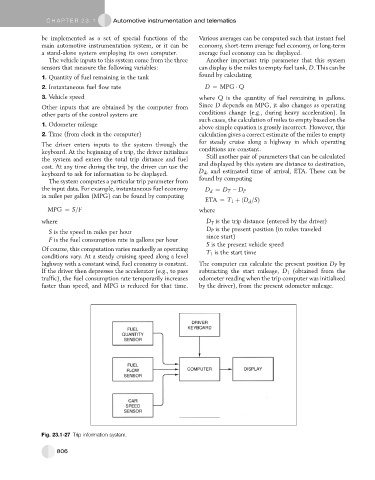Page 795 - Automotive Engineering Powertrain Chassis System and Vehicle Body
P. 795
CHAP TER 2 3. 1 Automotive instrumentation and telematics
be implemented as a set of special functions of the Various averages can be computed such that instant fuel
main automotive instrumentation system, or it can be economy, short-term average fuel economy, or long-term
a stand-alone system employing its own computer. average fuel economy can be displayed.
The vehicle inputs to this system come from the three Another important trip parameter that this system
sensors that measure the following variables: can display is the miles to empty fuel tank, D. This can be
found by calculating
1. Quantity of fuel remaining in the tank
2. Instantaneous fuel flow rate D ¼ MPG Q
3. Vehicle speed where Q is the quantity of fuel remaining in gallons.
Other inputs that are obtained by the computer from Since D depends on MPG, it also changes as operating
other parts of the control system are conditions change (e.g., during heavy acceleration). In
such cases, the calculation of miles to empty based on the
1. Odometer mileage
above simple equation is grossly incorrect. However, this
2. Time (from clock in the computer) calculation gives a correct estimate of the miles to empty
for steady cruise along a highway in which operating
The driver enters inputs to the system through the
keyboard. At the beginning of a trip, the driver initializes conditions are constant.
the system and enters the total trip distance and fuel Still another pair of parameters that can be calculated
cost. At any time during the trip, the driver can use the and displayed by this system are distance to destination,
keyboard to ask for information to be displayed. D d , and estimated time of arrival, ETA. These can be
The system computes a particular trip parameter from found by computing
the input data. For example, instantaneous fuel economy D ¼ D T D P
d
in miles per gallon (MPG) can be found by computing
ETA ¼ T 1 þðD =SÞ
d
MPG ¼ S=F where
where D T is the trip distance (entered by the driver)
D P is the present position (in miles traveled
S is the speed in miles per hour
since start)
F is the fuel consumption rate in gallons per hour
S is the present vehicle speed
Of course, this computation varies markedly as operating T 1 is the start time
conditions vary. At a steady cruising speed along a level
highway with a constant wind, fuel economy is constant. The computer can calculate the present position D P by
If the driver then depresses the accelerator (e.g., to pass subtracting the start mileage, D 1 (obtained from the
traffic), the fuel consumption rate temporarily increases odometer reading when the trip computer was initialized
faster than speed, and MPG is reduced for that time. by the driver), from the present odometer mileage.
Fig. 23.1-27 Trip information system.
806

